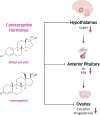Beyond Birth Control: The Neuroscience of Hormonal Contraceptives
- PMID: 39358019
- PMCID: PMC11450536
- DOI: 10.1523/JNEUROSCI.1235-24.2024
Beyond Birth Control: The Neuroscience of Hormonal Contraceptives
Abstract
Hormonal contraceptives (HCs) are one of the most highly prescribed classes of drugs in the world used for both contraceptive and noncontraceptive purposes. Despite their prevalent use, the impact of HCs on the brain remains inadequately explored. This review synthesizes recent findings on the neuroscience of HCs, with a focus on human structural neuroimaging as well as translational, nonhuman animal studies investigating the cellular, molecular, and behavioral effects of HCs. Additionally, we consider data linking HCs to mood disorders and dysregulation of the hypothalamic-pituitary-adrenal (HPA) axis and stress response as a potential mediator. The review also addresses the unique sensitivity of the adolescent brain to HCs, noting significant changes in brain structure and function when HCs are used during this developmental period. Finally, we discuss potential effects of HCs in combination with smoking-derived nicotine on outcomes of ischemic brain damage. Methodological challenges, such as the variability in HC formulations and user-specific factors, are acknowledged, emphasizing the need for precise and individualized research approaches. Overall, this review underscores the necessity for continued interdisciplinary research to elucidate the neurobiological mechanisms of HCs, aiming to optimize their use and improve women's health.
Copyright © 2024 the authors.
Conflict of interest statement
The authors declare no competing financial interests.
Figures


References
Publication types
MeSH terms
Substances
Grants and funding
LinkOut - more resources
Full Text Sources
